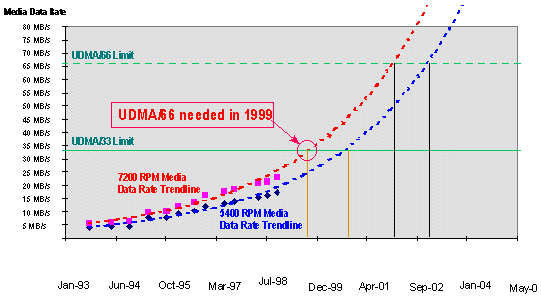Promise Ultra 66 - Ultra ATA/66 Controller
by Anand Lal Shimpi on March 25, 1999 8:13 PM EST- Posted in
- Storage
Understanding the Need
Here's the problem, you have this data stored on your hard drive and your computer needs to store it in system memory so you can manipulate it. This problem is something that we all face every day, whenever you open a document on your hard drive the disk reads the file, places it in its own buffer (memory) and copies it to your system RAM via your hard disk controller host's bus. The transfer protocol the host's bus uses states the theoretical maximum for performance out of the drive itself, so regardless of how fast your hard drive can read data off of its platter, the transfer protocol is the final decision maker as to what kind of performance you can achieve. Confused?
Let's see if we can simplify things, assume we have a hard drive that can read data off of its platter (data is stored on circular plates known as platters) at a rate of 2MB per second, and let's also assume that the drive has a 1MB buffer. In a single second, the drive is ready to transfer 1MB of data from the buffer to the computer's system memory and provided that the host bus is capable of providing transfer rates of up to 1MB per second, your hard drive will be able to operate at its potential without being restricted in any manner.
Hard drives cannot transfer at their theoretical maximum 100% of the time, in fact, very rarely do they achieve the maximum performance set by their transfer protocols, instead they achieve their theoretical maximum levels of performance in bursts, which is where the term burst transfer rate comes from. This is different from sustained transfer rate which is often much lower than the theoretical maximum of the drive, and is generally the performance you can expect from your hard drive.
Let's take a look at the same hard drive from before, and let's assume that the host bus is capable of providing transfer rates of up to 512KB (1/2MB) per second. While your hard drive may be ready to transfer the 1MB of data it just read from its platter to its buffer after a second, the host bus can only allow for a maximum of half of that data, or 512KB, to be transferred from the buffer to the computer's system memory in a single second. Here's where the problem arises, since the example hard drive only has a 1MB buffer, while waiting for the first 512KB of data to transfer down the bus it can only read another 512KB into its buffer since the bus can only transfer at 512KB per second. It's like having a 100-gallon water tank but only having a pump capable of moving 1 gallon per hour, you have the potential to do much more, but an external force is limiting you.

Copyright 1999 Western Digital
This was the case with the old DMA Mode 2 (or PIO Mode 4) transfer protocol standard whose 16.6MB/s burst transfer rate was quickly becoming a bottleneck for newer hard drives. At that point came the need for Ultra ATA/33 that effectively doubled the maximum burst transfer rate to 33.3MB/s. Two years later, it seems as if the advancements in hard disk storage technology have brought us to that limit once again, so break out the calculators, as we're about to double the theoretical maximum once again, Ultra ATA/66 is upon us.










0 Comments
View All Comments